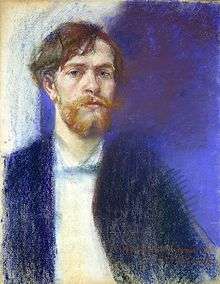Art in Poland
Art in Poland refers to all forms of visual art in or associated with Poland.
Polish art has always reflected European trends while maintaining its unique character. The Kraków school of Historicist painting developed by Jan Matejko produced monumental portrayals of customs and significant events in Polish history. Stanisław Witkiewicz was an ardent supporter of Realism in Polish art, its main representative being Jozef Chełmoński.
The Młoda Polska (Young Poland) movement witnessed the birth of modern Polish art and engaged in a great deal of formal experimentation led by Jacek Malczewski (Symbolism), Stanisław Wyspiański, Józef Mehoffer, and a group of Polish Impressionists. Artists of the twentieth-century Avant-Garde represented various schools and trends. The art of Tadeusz Makowski was influenced by Cubism; while Władysław Strzemiński and Henryk Stażewski worked within the Constructivist idiom. Distinguished contemporary artists include Roman Opałka, Leon Tarasewicz, Jerzy Nowosielski, Wojciech Siudmak, Mirosław Bałka, and Katarzyna Kozyra and Zbigniew Wąsiel in the younger generation. The most celebrated Polish sculptors include Xawery Dunikowski, Katarzyna Kobro, Alina Szapocznikow and Magdalena Abakanowicz. Since the inter-war years, Polish art and documentary photography has enjoyed worldwide recognition. In the sixties the Polish Poster School was formed, with Henryk Tomaszewski and Waldemar Świerzy at its head.[1]
See also
References
|
|---|
| Sovereign states | |
|---|
|
- Abkhazia
- Kosovo
- Nagorno-Karabakh
- Northern Cyprus
- South Ossetia
- Transnistria
|
|---|
|
- Åland Islands
- Faroe Islands
- Gibraltar
- Guernsey
- Jersey
- Isle of Man
- Svalbard and Jan Mayen
|
|---|








